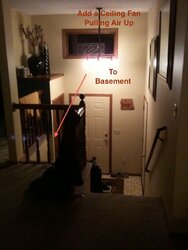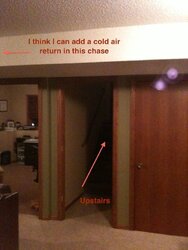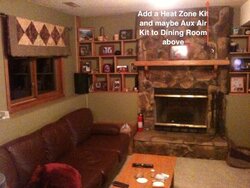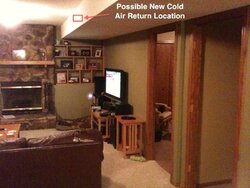I'm looking to start a discussion about some general concepts about the best way to get the heat distribution around the home. I will be installing a new Heat & Glow Northstar OR a Quadrafire 7100 in the next few weeks. We have an huge supply of oak firewood on our property and are getting a great deal on the fire place, so now is the time! The decision between the 2 fireplaces will largely be decided on which one my wife likes the look of best. The differences between the two are negligible otherwise.
Here are the details of our home and install plan:
-We are replacing a cheap inefficient wood burning unit.
-Our 4 bedroom, 2 bath, 2000 sq/ft, split-level home does NOT have an open floor plan unfortunately (8' ceilings throughout), so heat distribution is bigger challenge for me than in many newer homes.
-The fireplace is in the walkout basement living room (about 14'x25' with 8' ceilings) with one 30" doorway leading upstairs.
-The fireplace will be installed in a framed chimney chase.
-I will be utilizing at least 1 "heat zone kit" to blow hot air into the dining room directly above the fireplace.
-The closest cold air return is on the opposite side of the room at floor level.
-I may be able to install a cold air return easily at the ceiling level, anywhere along the long side of the room
-The fireplace will supplement heat from our furnace
-We run the furnace FAN continuously when heating or cooling to even out the temps in the house, which is moderately helpful, but I think it could be better with more well thought out cold air return placements.
I am concerned that I will "cook" right out of the basement living room unless I really am able to effectively move the heat to the rest of the house. Heck it gets pretty darn warm down there with the current fireplace. I plan to distribute the heat some or all of the following 4 ways: 1. the blower fan on the fireplace 2. the heat zone kit blowing warm air to the room upstairs, 3. a ceiling fan in the entryway of the house to pull/push air up/downstairs, 4. with strategically placed cold air returns.
My biggest question is regarding the returns the cold air return vents. Should I be thinking about the air circulation in the home in terms of PULLING WARM air from the BASEMENT through the returns (by opening more returns downstairs than upstairs) and PUSHING WARMER air out the heat vents UPSTAIRS? OR the opposite by PULLING COOL air from the UPSTAIRS through the returns (by opening more returns upstairs than downstairs) and PUSHING COOLER air out the heat vents DOWNSTAIRS? The later would theoretically create a positive pressure in the basement and help the natural movement of warm air rising up the stairway.
If you have made it reading this far...THANK YOU! Any suggestions or input you have is greatly appreciated!
Here are the details of our home and install plan:
-We are replacing a cheap inefficient wood burning unit.
-Our 4 bedroom, 2 bath, 2000 sq/ft, split-level home does NOT have an open floor plan unfortunately (8' ceilings throughout), so heat distribution is bigger challenge for me than in many newer homes.
-The fireplace is in the walkout basement living room (about 14'x25' with 8' ceilings) with one 30" doorway leading upstairs.
-The fireplace will be installed in a framed chimney chase.
-I will be utilizing at least 1 "heat zone kit" to blow hot air into the dining room directly above the fireplace.
-The closest cold air return is on the opposite side of the room at floor level.
-I may be able to install a cold air return easily at the ceiling level, anywhere along the long side of the room
-The fireplace will supplement heat from our furnace
-We run the furnace FAN continuously when heating or cooling to even out the temps in the house, which is moderately helpful, but I think it could be better with more well thought out cold air return placements.
I am concerned that I will "cook" right out of the basement living room unless I really am able to effectively move the heat to the rest of the house. Heck it gets pretty darn warm down there with the current fireplace. I plan to distribute the heat some or all of the following 4 ways: 1. the blower fan on the fireplace 2. the heat zone kit blowing warm air to the room upstairs, 3. a ceiling fan in the entryway of the house to pull/push air up/downstairs, 4. with strategically placed cold air returns.
My biggest question is regarding the returns the cold air return vents. Should I be thinking about the air circulation in the home in terms of PULLING WARM air from the BASEMENT through the returns (by opening more returns downstairs than upstairs) and PUSHING WARMER air out the heat vents UPSTAIRS? OR the opposite by PULLING COOL air from the UPSTAIRS through the returns (by opening more returns upstairs than downstairs) and PUSHING COOLER air out the heat vents DOWNSTAIRS? The later would theoretically create a positive pressure in the basement and help the natural movement of warm air rising up the stairway.
If you have made it reading this far...THANK YOU! Any suggestions or input you have is greatly appreciated!






